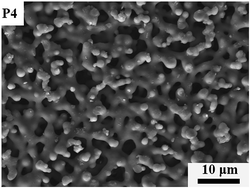A novel light diffuser based on the combined morphology of polymer networks and polymer balls in a polymer dispersed liquid crystals film
Abstract
A novel light diffuser based on a thermally cured polymer dispersed liquid crystal (PDLC) film was facilely fabricated by the thermal curing of epoxy monomers with thiols and polyamine (PA) in a composite solution of monomers and liquid crystals (LCs) sandwiched by two clean polyethylene terephthalate (PET) substrates. Varied amounts of LCs, diluent effects of epoxy resins and thiols and different curing temperatures have been investigated in the preparation of the films, and the optical properties (total transmittance and transmittance haze) and the light diffusing abilities of these films were also studied. As the microstructures of the polymers in the films were analysed using light scattering theory, it was revealed that the total transmittance of the novel light diffuser, with a combined polymer morphology of polymer networks and polymer balls, can reach 93% by simultaneously possessing a high transmittance haze (95%). The novel light diffuser, based on thermally cured PDLCs, possesses a good diffusion capacity and will have promising potential applications in military projects and liquid crystal display (LCDs) devices.



 Please wait while we load your content...
Please wait while we load your content...